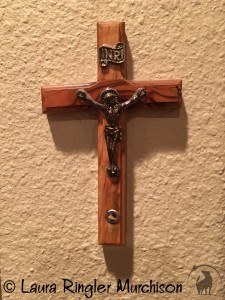I have always puzzled over the term “Good Friday” for the day Christ was crucified. In the Anglican and Episcopal church this is one of only two fasting days in the church calendar. I try not to remind my husband because he gets nervous and eats everything in sight! This is also a time for walking the Stations of the Cross. In a lot of “higher” churches (closer to Orthodox, Catholic and Anglican) there are a series of images all around the inside of the sanctuary depicting Jesus on this, the day of His crucifixion. The stations evolved from imitations of the Via Dolorosa (Way of Sorrows) in Jerusalem which is believed to be the actual path Jesus walked to Mount Calvary. The object of the stations is to help the faithful make a spiritual pilgrimage through contemplation of Christ’s Passion. Generally 14 images are arranged in numbered order along a path around the church. They are typically small plaques with reliefs or paintings placed around the church’s nave, or main body of the church. It provides the central approach to the high altar. The term “nave” is from medieval Latin which means “ship” and was an early Christian symbol. The stations vary but most commonly are:
- Jesus is condemned to death.
- Jesus carries His cross.
- Jesus falls the first time.
- Jesus meets his mother.
- Simon of Cyrene helps Jesus carry the cross.
- Veronica wipes the face of Jesus.
- Jesus falls the second time.
- Jesus meets the women of Jerusalem.
- Jesus falls the third time.
- Jesus is stripped of His garments.
- Jesus is nailed to the cross.
- Jesus dies on the cross.
- Jesus is taken down from the cross.
- Jesus is laid in the tomb.
Also, the Eucharist (the body and blood of Christ) is administered pre-sanctified (consecrated from the Maundy Thursday service). This is the only time the Christ candle is not lit to show He is not present and suffered in Hell before rising from the dead. I shall close this evening with the words of the traditional hymn by Venantius Fortunatus (530-609) used extensively in the Church’s public prayer and liturgy:
Crux fidelis
Faithful cross, above all other: one and only noble tree! None in foliage, none in blossom, none in fruit thy peer may be: sweetest wood and sweetest iron, sweetest weight is hung on thee. Amen.

